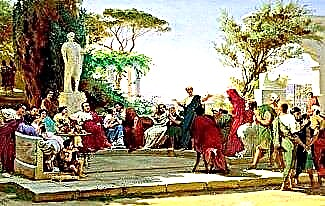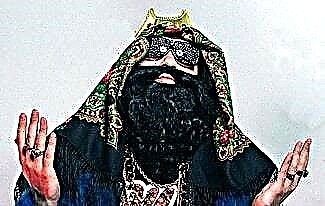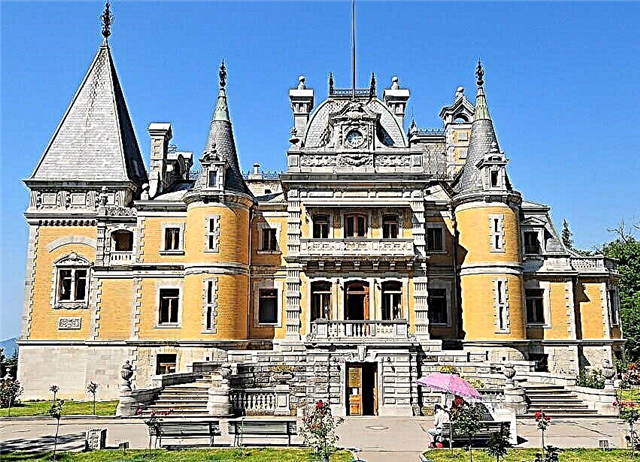Varlam Tikhonovich Shalamov (1907-1982) - Russian Soviet prose writer and poet, best known as the author of the cycle of works "Kolyma Tales", which tells about the life of prisoners of Soviet forced labor camps in the period 1930-1950.
In total, he spent 16 years in camps in Kolyma: 14 in general work and as a prisoner paramedic and 2 more after his release.

There are many interesting facts in the biography of Shalamov, which we will talk about in this article.
So, before you is a short biography of Varlam Shalamov.
Biography of Shalamov
Varlam Shalamov was born on June 5 (18), 1907 in Vologda. He grew up in the family of an Orthodox priest Tikhon Nikolaevich and his wife Nadezhda Alexandrovna. He was the youngest of 5 surviving children of his parents.
Childhood and youth
The future writer from an early age was distinguished by curiosity. When he was only 3 years old, his mother taught him to read. After that, the child devoted a lot of time only to books.
Soon Shalamov began to write his first poems. At the age of 7, his parents sent him to a men's gymnasium. However, due to the outbreak of the revolution and the Civil War, he was able to graduate from school only in 1923.

With the coming to power of the Bolsheviks, propagandizing atheism, the Shalamov family had to endure many troubles. An interesting fact is that one of the sons of Tikhon Nikolaevich, Valery, publicly denied his own father, a priest.
Beginning in 1918, Sr. Shalamov ceased to receive payments due to him. His apartment was robbed and later compacted. To help his parents, Varlam sold pies that his mother baked in the market. Despite severe persecution, the head of the family continued to preach even when he became blind in the early 1920s.
After graduating from school, Varlam wanted to get a higher education, but since he was the son of a clergyman, the guy was forbidden to study at the university. In 1924 he left for Moscow, where he worked at a leather processing factory.
During the biography of 1926-1928. Varlam Shalamov studied at Moscow State University at the Faculty of Law. He was expelled from the university "for hiding social origin."
The fact is that when filling out the documents, the applicant designated his father as a “disabled employee,” and not a “clergyman,” as his fellow student indicated in the denunciation. This was the beginning of repressions, which in the future will radically overlap Shalamov's entire life.
Arrests and imprisonment
In his student years, Varlam was a member of a discussion circle, where they condemned the total concentration of power in the hands of Stalin and his departure from Lenin's ideals.
In 1927, Shalamov took part in a protest in honor of the 10th anniversary of the October Revolution. Together with like-minded people, he called for the resignation of Stalin and the return to the precepts of Ilyich. A couple of years later, he was arrested for the first time as an accomplice of the Trotskyist group, after which he was sent to a camp for 3 years.
From this moment in the biography, the long-term prison ordeals of Varlam begin, which will continue for more than 20 years. He served his first term in the Vishersky camp, where in the spring of 1929 he was transferred from the Butyrka prison.
In the north of the Urals, Shalamov and other prisoners built a large chemical plant. In the fall of 1931, he was released ahead of schedule, as a result of which he could return to Moscow again.
In the capital, Varlam Tikhonovich was engaged in writing, collaborating with production publishing houses. About 5 years later, he was again reminded of the "Trotskyist views" and accused of counter-revolutionary activities.

This time the man was sentenced to 5 years, having sent him to Magadan in 1937. Here he was assigned to the most difficult types of work - gold mining face mines. Shalamov was to be released in 1942, but according to a government decree, prisoners were not allowed to be released until the end of the Great Patriotic War (1941-1945).
At the same time, Varlam was continuously "imposed" on new terms under a variety of articles, including the "case of lawyers" and "anti-Soviet sentiments." As a result, its term increased to 10 years.
Over the years of his biography, Shalamov managed to visit 5 Kolyma mines, working in mines, digging trenches, felling wood, etc. With the outbreak of the war, the state of affairs deteriorated in a special way. The Soviet government significantly reduced the already small ration, as a result of which the prisoners looked like the living dead.
Each prisoner thought only about where to get at least a little bread. The unfortunate people drank a decoction of pine needles to prevent the development of scurvy. Varlamov repeatedly lay in camp hospitals, balancing between life and death. Exhausted by hunger, hard work and lack of sleep, he decided to escape with the other prisoners.

The unsuccessful escape only made the situation worse. As a punishment, Shalamov was sent to the penalty area. In 1946, in Susuman, he managed to convey a note to a doctor he knew, Andrei Pantyukhov, who made every effort to place the sick prisoner in the medical unit.
Later, Varlamov was allowed to take an 8-month course for paramedics. The living conditions at the courses were incomparable with the camp regime. As a result, until the end of his term, he worked as a medical assistant. According to Shalamov, he owes his life to Pantyukhov.
Having received his release, but being infringed on his rights, Varlam Tikhonovich worked for another 1.5 years in Yakutia, collecting money for a ticket home. He was able to come to Moscow only in 1953.
Creation
After the end of the first term, Shalamov worked as a journalist in the capital's magazines and newspapers. In 1936, his first story was published in the pages of "October".
The link to correctional camps radically transformed his work. While serving his sentence, Varlam continued to write down poetry and make sketches for his future works. Even then, he set out to tell the whole world the truth about what was happening in the Soviet camps.
Returning home, Shalamov devoted himself entirely to writing. The most popular was his famous cycle "Kolyma Tales", written in 1954-1973.
In these works, Varlam described not only the conditions of detention of prisoners, but also the fate of people broken by the system. Deprived of everything necessary for a full life, a person ceased to be a person. According to the writer, the capacity for compassion and mutual respect atrophies in the prisoner when the issue of survival comes to the fore.
The writer was against the publication of "Kolyma stories" as a separate publication, therefore, in full collection, they were published in Russia after his death. It is worth noting that a film was shot based on this work in 2005.
An interesting fact is that Shalamov was critical of Alexander Solzhenitsyn, the author of the cult "Gulag Archipelago". In his opinion, he made a name for himself by speculating on the camp theme.
Over the years of his creative biography, Varlam Shalamov published dozens of poetry collections, wrote 2 plays and 5 autobiographical stories and essays. In addition, his essays, notebooks and letters deserve special attention.
Personal life
Varlam's first wife was Galina Gudz, whom he met in Vishlager. According to him, he "stole" her from another prisoner, to whom the girl came on a date. This marriage, in which the girl Elena was born, lasted from 1934 to 1956.
During the second arrest of the writer, Galina was also subjected to repression and was exiled to a remote village of Turkmenistan. She lived there until 1946. The couple managed to meet only in 1953, but soon they decided to leave.
After that, Shalamov married the children's writer Olga Neklyudova. The couple lived together for 10 years - there were no common children. After the divorce in 1966 and until the end of his life, the man lived alone.
Death
In the last years of his life, the state of health of Varlam Tikhonovich was extremely difficult. Decades of exhausting work at the limit of human capabilities made themselves felt.
Back in the late 1950s, the writer received a disability due to Meniere's disease - a disease of the inner ear, which is characterized by recurrent attacks of progressive deafness, tinnitus, dizziness, imbalance and autonomic disorders. In the 70s, he lost his sight and hearing.
Shalamov could no longer coordinate his own movements and moved with difficulty. In 1979 he was placed in the House of Invalids. A couple of years later, he suffered a stroke, as a result of which they decided to send him to a psychoneurological boarding school.
In the process of transportation, the old man caught a cold and fell ill with pneumonia, which led to his death. Varlam Shalamov died on January 17, 1982 at the age of 74. Although he was an atheist, his physician, Elena Zakharova, insisted that he be buried according to the Orthodox tradition.
Shalamov Photos
















